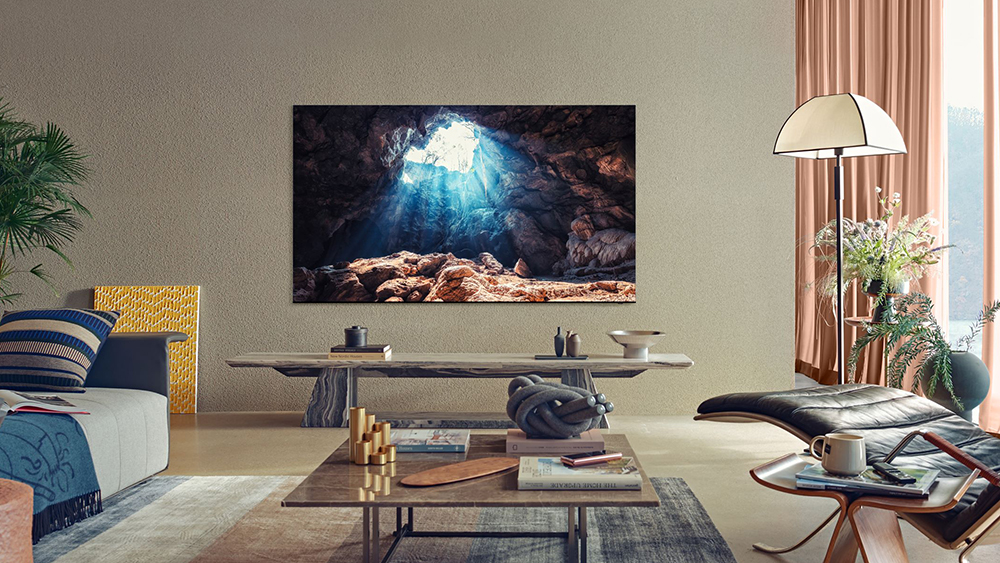Samsung has just taken the covers off its 2021 TV range, and there’s some extremely impressive-seeming technology right at the heart of it. While the company is pushing MicroLED as the TV tech of the future (potentially followed by self-emissive quantum dots), it’s utilising miniaturised LEDs in the backlights of this year’s QLEDs.
Samsung explains that the majority of a typical LED’s size is made up of its protective packaging and light-guiding lens, both of which it’s done away with for its so-called ‘New LEDs’. Not only that, it’s also miniaturised the LEDs themselves, to quite astonishing effect.
As part of a video presentation (the coronavirus pandemic has prevented us visiting Samsung’s HQ in person), Samsung demonstrated the degree of difference by putting a petri dish containing 100 traditional backlight LEDs next to another containing its New LEDs. The traditional LEDs are big and clear, filling their dish, while the New LEDs genuinely look like nothing more than sparkly grains of sand. Samsung says the New LEDs are a fortieth the size of traditional LEDs, but even that doesn’t convey how incredibly tiny they appear.
Instead of a lens, Samsung’s New LED backlights use a new ‘micro layer’ that guides the light through the quantum dots (which provide the set’s colours). The result is apparently no light leakage or blooming, and because the New LEDs are so much smaller, significantly more of them can be packed in. One slide we saw referred to “ten-times greater density”: given that Samsung’s top 2020 model, the Q950TS, is said to have around 500 dimming zones (Samsung generally doesn’t offer specific numbers), we’re potentially talking about around 5000 zones for these Neo QLEDs.
Of course, Samsung isn’t the first TV brand to utilise Mini LEDs, but the company claims that its are the smallest and most precise out there – mind you, that was before LG announced its own Mini LED TVs.
The Samsung Neo QLED TVs are powered by a new ‘Quantum Processor’ that apparently brings with it, among other things, more precise dimming and a local power distribution feature that sends power to the brightest areas of the picture and away from the darker parts. It also works in conjunction with a sensor integrated into the TV’s frame to adjust brightness and contrast in response to ambient lighting conditions.
The most premium models (QN90A and above) feature Samsung’s Ultra Viewing Angle tech, which has impressed us in the past, and models QN85A and above also boast Anti-Reflective panels.
Every model specifically referenced so far is also impressively thin: the 8K QN900A and QN800A models retain the 15mm depth measurement of the outgoing Q950TS/Q900TS, while every 4K model appears to be 25mm deep – even the Q70 and Q60, the outgoing versions of which are 57mm thick.
There’s a new version of the One Connect system, too, which sees all of the TV’s connections (and even power) routed through a discrete processing box. For 2021, that box has been massively slimmed down to the extent that it can even be attached to the rear of the pedestal stand. All models QN95A and above get One Connect.
In terms of sound, Samsung is continuing with its OTS (Object-Tracking Sound) technology. For 2021, there will be four versions of OTS, ranging from OTS Lite, which has just two physical speakers at the bottom and two ‘virtual speakers’ for height, to OTS Pro, which boasts speakers along the top, bottom and both sides. All 2021 QLEDs (and even a couple of LCD models) get some form of OTS.
On the gaming front, meanwhile, Samsung is quoting an input lag of just 9.8ms, plus ongoing support for 4K@120Hz (on Q70 and above), ALLM, VRR (G-Sync and FreeSync Premium Pro) and HGiG. Interestingly, you’ll also be able to switch the screen into ultra-wide screen ratios such as 21:9 or 32:9, simulating the experience of using a gaming monitor, although the heavy black bars top and bottom seem rather off-putting.
While that’s already rather a lot of info to digest, there’s actually still a lot we don’t know about Samsung’s 2021 TV range.
It’s little surprise that pricing and availability are being kept under wraps for now, but Samsung has also resisted supplying a complete range breakdown at this stage, leaving us to piece together snippets from the hours of video presentations and attempt to figure out the various model numbers and which features apply to each. You’ll find the fruits of those labours in our work-in-progress Samsung 2021 TV line-up feature.
MORE:
Samsung 2021 TV lineup: everything you need to know
LG announces QNED TVs with Mini LED technology
CES 2021: all the news from the first all-digital CES
